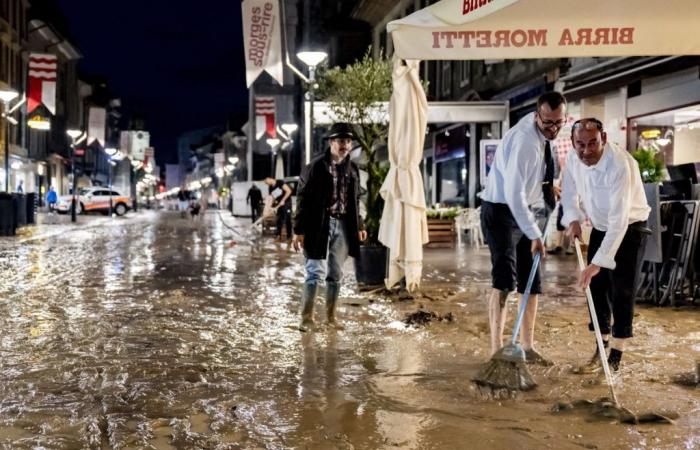– “The more built-up areas there are, the greater the risk of damage.”
Repeated bad weather causes millions of francs worth of damage… and it’s not over yet. Balz Grollimund, expert in disaster risk modelling at Swiss Re, explains what awaits us in Switzerland.
Published today at 09:03
Morges, Wednesday, June 26. A storm caused significant flooding in the city center, as here, on the Grand-Rue.
LAURENT GILLIERON/Keystone
Subscribe now and enjoy the audio playback feature.
BotTalk
Flood of the century in Morges, disrupted road and rail traffic and hundreds of firefighters in French-speaking Switzerland… For some time now, the violent rainstorms and hail that regularly hit Switzerland have been causing damages in the millions. And that is not going to change, according to Balz Grollimund. Head of development of catastrophe risk models at the insurer of insurers Swiss Re, he explains…
From Graubünden to Lake Geneva, via Morges, Zermatt, Basel, Schaffhausen and Geneva, floods follow one another. Are these exceptional events?
Such events have always existed and are becoming more frequent due to global warming. Heavy precipitation tends to occur more often and more intensely. When it rains this much and the ground is saturated with water, the risk of heavy mudslides increases.
Over the past twenty years, Switzerland has invested billions in flood protection. Has this helped reduce the damage?
Indeed, we have invested a lot – such as in the renaturation of rivers to better control the consequences of flooding. But, at the same time, we are seeing a trend increase in heavy rains. Add damage to buildings caused by hail or windstorms. Some remember the storms Lothar et Martin in 1999, which devastated all of Europe and Switzerland. Certainly, there have been no more such terrible storms. But the danger has not yet disappeared.
2023 was the hottest year ever recorded, with a maximum number of violent storms. Will we reach new records in 2024?
For around fifteen years, insured losses resulting from natural disasters have been increasing on a global scale – between 5 to 7% per year. Last year, for the fourth time in a row, they crossed the $100 billion mark. Two-thirds of the damage was due to severe thunderstorms combined with hail, flooding and tornadoes. There is no reason to think the trend will change.
Why is the amount of damages increasing so much?
Several factors combine: on the one hand, inflation increases the value of buildings and the cost of repairs. On the other hand, cities expand and economic growth increases prosperity. As a result, people own more property. When a natural disaster occurs, the damage is much greater than before.
That’s to say?
Urbanisation is progressing very rapidly worldwide. As a result, most of the population growth and increase in wealth is concentrated in cities. Disasters cause more damage there, because they are often located near the sea, rivers or lakes, where flooding is potentially more frequent. The damage is then greater. And the more built-up areas there are, the greater the risk of damage. In addition, many insured objects, such as photovoltaic systems, modern façade cladding or slatted blinds, are more susceptible to hail.
Shouldn’t the extent of the damage cause huge losses for insurers?
For some direct insurers, this can actually be reflected in the bottom line, depending on the risks on their books. Overall, despite the billions in losses, 2023 was a profitable year for natural hazard insurers. This allows the industry to build up the necessary reserves to be able to absorb shocks when a natural disaster strikes.
Practically, what does this mean?
Reinsurers like Swiss Re are there to take on the major risks that a direct insurer cannot assume alone. We determine a price per risk. This sends a signal to consumers. They can then choose between buying better quality tiles and more resistant solar panels or paying higher insurance premiums.
At Swiss Re, is risk calculation based on official data or on climate models developed internally?
We are one of the few reinsurers to have our own team of around 50 scientists to model risks. We refer to both external data sources and our own estimates.
Are there regions in Switzerland where the risks are so high that insurers are no longer willing to cover them?
Buildings located in areas of maximum danger in terms of flooding, landslides, avalanches or landslides are practically not insurable. In my opinion, building permits should no longer be granted in these areas for new buildings.
In the long term, in Switzerland, the risk of forest fires will increase, this may become problematic for buildings directly exposed to forest fires. Because here too, summers tend to become drier.
“Latest news”
Want to stay on top of the news? «24 heures» offers you two appointments per day, directly in your e-mail box. So you don’t miss anything that’s happening in your Canton, in Switzerland or in the world.
Other newsletters
To log in
Did you find an error? Please report it to us.
0 comments






